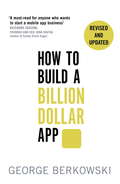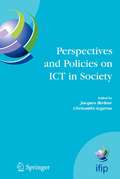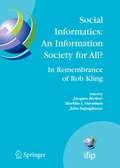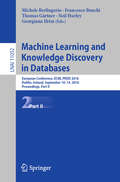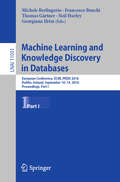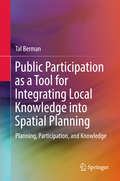- Table View
- List View
How to Build a Billion Dollar App: Discover the secrets of the most successful entrepreneurs of our time
by George BerkowskiTHE ULTIMATE GUIDE TO BUILDING AN APP-BASED BUSINESS 'A must read for anyone who wants to start a mobile app business' Riccardo Zacconi, founder and CEO King Digital (maker of Candy Crush Saga) 'A fascinating deep dive into the world of billion-dollar apps. Essential reading for anyone trying to build the next must-have app' Michael Acton Smith, Founder and CEO, Mind Candy Apps have changed the way we communicate, shop, play, interact and travel and their phenomenal popularity has presented possibly the biggest business opportunity in history.In How to Build a Billion Dollar App, serial tech entrepreneur George Berkowski gives you exclusive access to the secrets behind the success of the select group of apps that have achieved billion-dollar success.Berkowski draws exclusively on the inside stories of the billion-dollar app club members, including Instagram, Whatsapp, Snapchat, Candy Crush and Uber to provide all the information you need to create your own spectacularly successful mobile business. He guides you through each step, from an idea scribbled on the back of an envelope, through to finding a cofounder, building a team, attracting (and keeping) millions of users, all the way through to juggling the pressures of being CEO of a billion-dollar company (and still staying ahead of the competition).If you've ever dreamed of quitting your nine to five job to launch your own company, you're a gifted developer, seasoned entrepreneur or just intrigued by mobile technology, How to Build a Billion Dollar App will show you what it really takes to create your own billion-dollar, mobile business.
Perspectives and Policies on ICT in Society: An IFIP TC9 (Computers and Society) Handbook (IFIP Advances in Information and Communication Technology #179)
by Jacques Berleur Chrisanthi AvgerouGovernments, the media, the information technology industry and scientists publicly argue that information and communication technologies (ICT) will bring about an inevitable transition from "industrial" to "information" or "knowledge-based" economies and societies. It is assumed that all aspects of our economic and social lives, in both the public and private spheres, will be radically different from what they are today. The World Summit on the Information Society (Geneva 2003 - Tunis 2005) shows the importance of a worldwide reflection on those topics. Perspectives and Policies on ICT in Society explores the ICT policies of different nations and regions such as Africa, China, Europe, and India. The authors assess the arguments surrounding the impending new age, as well as some of the more sensitive issues of its developments. This progress will signal an expansion of ICT in many domains - the so-called ubiquity - such as in the workplace, the home, government, and education and it will affect privacy and professional ethics. The expansion will also encompass all parts of the earth, particularly developing countries. Such growth must take place in the context of historical dimensions and should underscore the accountability of professionals in the field. The intent of this book is to address these issues and to serve as a handbook of IFIP's TC9 "Computers and Society" committee. Thirty authors from twelve countries consider the ICT policies with their associated perspectives and they explore what may be the information age and the digital society of tomorrow. The book provides reflection on today's complex society and addresses the uncertain developments rising from an increasingly global and technologically connected world. Jacques Berleur is at the University of Namur, Belgium, and Chrisanthi Avgerou at the London School of Economics, United Kingdom.
Social Informatics: Proceedings of the Seventh International Conference 'Human Choice and Computers' (HCC7), IFIP TC 9, Maribor, Slovenia, September 21-23, 2006 (IFIP Advances in Information and Communication Technology #223)
by Jacques Berleur Markku I. Nurminen John ImpagliazzoThe principal message of the ‘Human Choice and Computers’ (HCC) tradition and its associated conferences over the years is that there are choices and alternatives. In this volume, Social Informatics takes two directions. The first supports readers in interpreting of the meaning of Social Informatics. The second, more extensive part develops an overview of various applications of Social Informatics. Researchers inspired by Social Informatics touch many areas of human and social life.
Bewertungskulturen (Soziologie des Wertens und Bewertens)
by Oliver Berli Stefan Nicolae Hilmar SchäferBewertungsphänomene wie Rankings und Ratings sind in Gegenwartsgesellschaften weit verbreitet. Sie werfen gleichermaßen theoretische wie politische Fragen auf und fordern die soziologische Analyse heraus. Der Band versammelt Studien zu Bewertungsphänomen in unterschiedlichen sozialen Sphären (u.a. Alltag, digitalen Medien, Kultur, Sport und Wissenschaft) und bringt sie miteinander ins Gespräch. Zugleich wirbt er für eine konsequent vergleichende Perspektive, die unterschiedliche Bewertungskulturen in Gegenwartsgesellschaften umfassend nachzeichnet.
Who You Think I Am?: Masken in der Pop-Musik (Essays zur Gegenwartsästhetik)
by Sebastian BerlichPop-Stars sind uns nahe. In ihren Songs, ihren Bildern, ihren Stories auf Instagram. Gesucht ist ein authentischer Eindruck. Echte Gefühle auf echten Gesichtern. Aber was passiert, wenn sie ihr Gesicht mit einer Maske verdecken? Und zwar dauerhaft, als zweites Gesicht. Das Phänomen findet sich im Mainstream wie im Underground. Die Maske bricht dabei nicht mit dem Ideal von Authentizität. Vielmehr verweist sie je nach Inszenierung auf verschiedenste Diskurse, kann cool oder grotesk wirken, zum Logo werden oder Anonymität herstellen. Der Essay zeigt an zwei Beispielfällen (Sido, Slipknot), wie die Maske die Persona von Pop-Stars konstruiert – und enthüllt damit Strukturen der Pop-Musik.
Who You Think I Am?: Masks in Pop Music
by Sebastian BerlichPop stars are close to us. In their songs, their pictures, their stories on Instagram. What we are looking for is an authentic impression. Real feelings on real faces. But what happens when they cover their face with a mask? Permanently, as a second face. The phenomenon can be found in the mainstream as well as in the underground. The mask does not break with the ideal of authenticity. Rather, depending on how it is staged, it refers to the most diverse discourses, can appear cool or grotesque, become a logo or create anonymity. The essay uses mainly two examples (Sido, Slipknot) to show how the mask constructs the persona of pop stars - and thus reveals structures of pop music.
Strategic Factors In U.S. Health Care: Human Resources, Capital, And Technology
by Howard S BerlinerThe Conservation of Human Resources, Columbia University, of which I am the director, has been carrying out over the past three years an inquiry into selected forces that are altering the structure and functioning of the U.S. health care system. The funding for the project was provided by the Robert Wood Johnson Foundation and the principal investigator was Howard Berliner, an Associate Research Scholar on the Conservation staff.
Strategic Factors In U.S. Health Care: Human Resources, Capital, And Technology
by Howard S BerlinerThe Conservation of Human Resources, Columbia University, of which I am the director, has been carrying out over the past three years an inquiry into selected forces that are altering the structure and functioning of the U.S. health care system. The funding for the project was provided by the Robert Wood Johnson Foundation and the principal investigator was Howard Berliner, an Associate Research Scholar on the Conservation staff.
Secularism on the Edge: Rethinking Church-State Relations in the United States, France, and Israel
by Jacques Berlinerblau Sarah Fainberg Aurora NouIn this dynamic and wide-ranging collection of essays, prominent scholars examine the condition of church-state relations in the United States, France, and Israel. Their analyses are rooted in a wide variety of disciplines, ranging from ethnography and demography to political science, gender studies, theology, and the law.
Machine Learning and Knowledge Discovery in Databases: European Conference, ECML PKDD 2018, Dublin, Ireland, September 10–14, 2018, Proceedings, Part II (Lecture Notes in Computer Science #11052)
by Michele Berlingerio Francesco Bonchi Thomas Gärtner Neil Hurley Georgiana IfrimThe three volume proceedings LNAI 11051 – 11053 constitutes the refereed proceedings of the European Conference on Machine Learning and Knowledge Discovery in Databases, ECML PKDD 2018, held in Dublin, Ireland, in September 2018. The total of 131 regular papers presented in part I and part II was carefully reviewed and selected from 535 submissions; there are 52 papers in the applied data science, nectar and demo track. The contributions were organized in topical sections named as follows: Part I: adversarial learning; anomaly and outlier detection; applications; classification; clustering and unsupervised learning; deep learningensemble methods; and evaluation. Part II: graphs; kernel methods; learning paradigms; matrix and tensor analysis; online and active learning; pattern and sequence mining; probabilistic models and statistical methods; recommender systems; and transfer learning. Part III: ADS data science applications; ADS e-commerce; ADS engineering and design; ADS financial and security; ADS health; ADS sensing and positioning; nectar track; and demo track.
Machine Learning and Knowledge Discovery in Databases: European Conference, ECML PKDD 2018, Dublin, Ireland, September 10–14, 2018, Proceedings, Part I (Lecture Notes in Computer Science #11051)
by Michele Berlingerio Francesco Bonchi Thomas Gärtner Neil Hurley Georgiana IfrimThe three volume proceedings LNAI 11051 – 11053 constitutes the refereed proceedings of the European Conference on Machine Learning and Knowledge Discovery in Databases, ECML PKDD 2018, held in Dublin, Ireland, in September 2018. The total of 131 regular papers presented in part I and part II was carefully reviewed and selected from 535 submissions; there are 52 papers in the applied data science, nectar and demo track. The contributions were organized in topical sections named as follows: Part I: adversarial learning; anomaly and outlier detection; applications; classification; clustering and unsupervised learning; deep learningensemble methods; and evaluation. Part II: graphs; kernel methods; learning paradigms; matrix and tensor analysis; online and active learning; pattern and sequence mining; probabilistic models and statistical methods; recommender systems; and transfer learning. Part III: ADS data science applications; ADS e-commerce; ADS engineering and design; ADS financial and security; ADS health; ADS sensing and positioning; nectar track; and demo track.
Talking Like Children: Language and the Production of Age in the Marshall Islands (Oxf Studies in Anthropology of Language)
by Elise BermanChildren in the Marshall Islands do many things that adults do not. They walk around half naked. They carry and eat food in public without offering it to others. They talk about things they see rather than hiding uncomfortable truths. They explicitly refuse to give. Why do they do these things? Many think these behaviors are a natural result of children's innate immaturity. But Elise Berman argues that children are actually taught to do things that adults avoid: to be rude, inappropriate, and immature. Before children learn to be adults, they learn to be different from them. Berman's main theoretical claim therefore is also a novel one: age emerges through interaction and is a social production. In Talking Like Children, Berman analyzes a variety of interactions in the Marshall Islands, all broadly based around exchange: adoption negotiations, efforts to ask for or avoid giving away food, contentious debates about supposed child abuse. In these dramas both large and small, age differences emerge through the decisions people make, the emotions they feel, and the power they gain. Berman's research includes a range of methods -- participant observation, video and audio recordings, interviews, children's drawings -- that yield a significant corpus of data including over 80 hours of recorded naturalistic social interaction. Presented as a series of captivating stories, Talking Like Children is an intimate analysis of speech and interaction that shows what age means. Like gender and race, age differences are both culturally produced and socially important. The differences between Marshallese children and adults give both groups the ability to manipulate social life in distinct but often complementary ways. These differences produce culture itself. Talking Like Children establishes age as a foundational social variable and a central concern of anthropological and linguistic research.
Talking Like Children: Language and the Production of Age in the Marshall Islands (Oxf Studies in Anthropology of Language)
by Elise BermanChildren in the Marshall Islands do many things that adults do not. They walk around half naked. They carry and eat food in public without offering it to others. They talk about things they see rather than hiding uncomfortable truths. They explicitly refuse to give. Why do they do these things? Many think these behaviors are a natural result of children's innate immaturity. But Elise Berman argues that children are actually taught to do things that adults avoid: to be rude, inappropriate, and immature. Before children learn to be adults, they learn to be different from them. Berman's main theoretical claim therefore is also a novel one: age emerges through interaction and is a social production. In Talking Like Children, Berman analyzes a variety of interactions in the Marshall Islands, all broadly based around exchange: adoption negotiations, efforts to ask for or avoid giving away food, contentious debates about supposed child abuse. In these dramas both large and small, age differences emerge through the decisions people make, the emotions they feel, and the power they gain. Berman's research includes a range of methods -- participant observation, video and audio recordings, interviews, children's drawings -- that yield a significant corpus of data including over 80 hours of recorded naturalistic social interaction. Presented as a series of captivating stories, Talking Like Children is an intimate analysis of speech and interaction that shows what age means. Like gender and race, age differences are both culturally produced and socially important. The differences between Marshallese children and adults give both groups the ability to manipulate social life in distinct but often complementary ways. These differences produce culture itself. Talking Like Children establishes age as a foundational social variable and a central concern of anthropological and linguistic research.
Creating the Market University: How Academic Science Became an Economic Engine
by Elizabeth Popp BermanAmerican universities today serve as economic engines, performing the scientific research that will create new industries, drive economic growth, and keep the United States globally competitive. But only a few decades ago, these same universities self-consciously held themselves apart from the world of commerce. Creating the Market University is the first book to systematically examine why academic science made such a dramatic move toward the market. Drawing on extensive historical research, Elizabeth Popp Berman shows how the government--influenced by the argument that innovation drives the economy--brought about this transformation. Americans have a long tradition of making heroes out of their inventors. But before the 1960s and '70s neither policymakers nor economists paid much attention to the critical economic role played by innovation. However, during the late 1970s, a confluence of events--industry concern with the perceived deterioration of innovation in the United States, a growing body of economic research on innovation's importance, and the stagnation of the larger economy--led to a broad political interest in fostering invention. The policy decisions shaped by this change were diverse, influencing arenas from patents and taxes to pensions and science policy, and encouraged practices that would focus specifically on the economic value of academic science. By the early 1980s, universities were nurturing the rapid growth of areas such as biotech entrepreneurship, patenting, and university-industry research centers. Contributing to debates about the relationship between universities, government, and industry, Creating the Market University sheds light on how knowledge and politics intersect to structure the economy.
Creating the Market University: How Academic Science Became an Economic Engine (PDF)
by Elizabeth Popp BermanAmerican universities today serve as economic engines, performing the scientific research that will create new industries, drive economic growth, and keep the United States globally competitive. But only a few decades ago, these same universities self-consciously held themselves apart from the world of commerce. Creating the Market University is the first book to systematically examine why academic science made such a dramatic move toward the market. Drawing on extensive historical research, Elizabeth Popp Berman shows how the government--influenced by the argument that innovation drives the economy--brought about this transformation. Americans have a long tradition of making heroes out of their inventors. But before the 1960s and '70s neither policymakers nor economists paid much attention to the critical economic role played by innovation. However, during the late 1970s, a confluence of events--industry concern with the perceived deterioration of innovation in the United States, a growing body of economic research on innovation's importance, and the stagnation of the larger economy--led to a broad political interest in fostering invention. The policy decisions shaped by this change were diverse, influencing arenas from patents and taxes to pensions and science policy, and encouraged practices that would focus specifically on the economic value of academic science. By the early 1980s, universities were nurturing the rapid growth of areas such as biotech entrepreneurship, patenting, and university-industry research centers. Contributing to debates about the relationship between universities, government, and industry, Creating the Market University sheds light on how knowledge and politics intersect to structure the economy.
Thinking like an Economist: How Efficiency Replaced Equality in U.S. Public Policy
by Elizabeth Popp BermanThe story of how economic reasoning came to dominate Washington between the 1960s and 1980s—and why it continues to constrain progressive ambitions todayFor decades, Democratic politicians have frustrated progressives by tinkering around the margins of policy while shying away from truly ambitious change. What happened to bold political vision on the left, and what shrunk the very horizons of possibility? In Thinking like an Economist, Elizabeth Popp Berman tells the story of how a distinctive way of thinking—an “economic style of reasoning”—became dominant in Washington between the 1960s and the 1980s and how it continues to dramatically narrow debates over public policy today.Introduced by liberal technocrats who hoped to improve government, this way of thinking was grounded in economics but also transformed law and policy. At its core was an economic understanding of efficiency, and its advocates often found themselves allied with Republicans and in conflict with liberal Democrats who argued for rights, equality, and limits on corporate power. By the Carter administration, economic reasoning had spread throughout government policy and laws affecting poverty, healthcare, antitrust, transportation, and the environment. Fearing waste and overspending, liberals reined in their ambitions for decades to come, even as Reagan and his Republican successors argued for economic efficiency only when it helped their own goals.A compelling account that illuminates what brought American politics to its current state, Thinking like an Economist also offers critical lessons for the future. With the political left resurgent today, Democrats seem poised to break with the past—but doing so will require abandoning the shibboleth of economic efficiency and successfully advocating new ways of thinking about policy.
The American Jewish Philanthropic Complex: The History of a Multibillion-Dollar Institution
by Lila Corwin BermanThe first comprehensive history of American Jewish philanthropy and its influence on democracy and capitalismFor years, American Jewish philanthropy has been celebrated as the proudest product of Jewish endeavors in the United States, its virtues extending from the local to the global, the Jewish to the non-Jewish, and modest donations to vast endowments. Yet, as Lila Corwin Berman illuminates in The American Jewish Philanthropic Complex, the history of American Jewish philanthropy reveals the far more complicated reality of changing and uneasy relationships among philanthropy, democracy, and capitalism.With a fresh eye and lucid prose, and relying on previously untapped sources, Berman shows that from its nineteenth-century roots to its apex in the late twentieth century, the American Jewish philanthropic complex tied Jewish institutions to the American state. The government’s regulatory efforts—most importantly, tax policies—situated philanthropy at the core of its experiments to maintain the public good without trammeling on the private freedoms of individuals. Jewish philanthropic institutions and leaders gained financial strength, political influence, and state protections within this framework. However, over time, the vast inequalities in resource distribution that marked American state policy became inseparable from philanthropic practice. By the turn of the millennium, Jewish philanthropic institutions reflected the state’s growing investment in capitalism against democratic interests. But well before that, Jewish philanthropy had already entered into a tight relationship with the governing forces of American life, reinforcing and even transforming the nation’s laws and policies.The American Jewish Philanthropic Complex uncovers how capitalism and private interests came to command authority over the public good, in Jewish life and beyond.
The American Jewish Philanthropic Complex: The History of a Multibillion-Dollar Institution
by Lila Corwin BermanThe first comprehensive history of American Jewish philanthropy and its influence on democracy and capitalismFor years, American Jewish philanthropy has been celebrated as the proudest product of Jewish endeavors in the United States, its virtues extending from the local to the global, the Jewish to the non-Jewish, and modest donations to vast endowments. Yet, as Lila Corwin Berman illuminates in The American Jewish Philanthropic Complex, the history of American Jewish philanthropy reveals the far more complicated reality of changing and uneasy relationships among philanthropy, democracy, and capitalism.With a fresh eye and lucid prose, and relying on previously untapped sources, Berman shows that from its nineteenth-century roots to its apex in the late twentieth century, the American Jewish philanthropic complex tied Jewish institutions to the American state. The government’s regulatory efforts—most importantly, tax policies—situated philanthropy at the core of its experiments to maintain the public good without trammeling on the private freedoms of individuals. Jewish philanthropic institutions and leaders gained financial strength, political influence, and state protections within this framework. However, over time, the vast inequalities in resource distribution that marked American state policy became inseparable from philanthropic practice. By the turn of the millennium, Jewish philanthropic institutions reflected the state’s growing investment in capitalism against democratic interests. But well before that, Jewish philanthropy had already entered into a tight relationship with the governing forces of American life, reinforcing and even transforming the nation’s laws and policies.The American Jewish Philanthropic Complex uncovers how capitalism and private interests came to command authority over the public good, in Jewish life and beyond.
Sociological Research and Urban Children and Youth (Sociological Studies of Children and Youth #32)
by Rachel Berman Patrizia Albanese Xiaobei ChenAlmost a third of the 4 billion people living in urban areas today are children, according to the United Nations. By 2050, 70 percent of the world’s children will live in cities. Yet how has recent sociological work engaged with children and youth living in cities around the world? What does a focus on children and youth in an urban context mean for researchers working within a variety of sociological frameworks? How have children’s and youth’s experiences shaped and been shaped by the diverse urban scapes and contexts in which they live? Sociological Research and Urban Children and Youth brings together cutting-edge work that addresses children’s and youth’s urban living experiences as well as the social, political, and ecological realities that accompany this. Featuring contributions from Australia, Canada, the U.K., and the United States, the chapters critically engage with core analytical and conceptual issues ranging from relationality to citizenship and belonging, to power, structure, and agency. Recognizing the potential research with and about young people can have in decision making on multiple levels of policy and service provision, Sociological Research and Urban Children and Youth provides a key foundation for considering the influence of urban environments on young people, and vice versa.
Public Participation as a Tool for Integrating Local Knowledge into Spatial Planning: Planning, Participation, and Knowledge
by Tal BermanThis book provides a state of the art approach to participatory planning, and generates innovative thought in planning theory and knowledge study. The book introduces a new conceptual framework for participatory planning, one which redefines concepts that have been taken for granted for too long: those of “public participation” and “local knowledge”. It draws on the rich repertoire of public participation practices that have developed globally over the last 50 years, and investigates the following questions: Which participatory practices most effectively capture residents’ genuine spatial needs, perceptions and desires? And how can these be incorporated into actual plans? The book is based on an empirical comparative examination of the effectiveness of various participatory processes, and proposes practical solutions for public participation through two new instruments: the Practices Evaluation Tool, and the Participatory Methods Ladder. These instruments calibrate participation methods according to certain criteria, in order to improve their ability to extract local knowledge and incorporate it into planning deliverables. These new instruments correspond to and elaborate on Arnstein’s ladder - the 1969 theoretical landmark for participatory planning. Both academics and practitioners in the area of urban and regional planning will find this book to be an invaluable resource, given the way it develops both theoretical and practical cutting-edge outcomes.
Point of Arrival: A Study of London's East End (Routledge Library Editions: Immigration and Migration #19)
by Chaim BermantPoint of Arrival (1975) examines the experiences of the various immigrant groups – the Huguenots, Irish, Jews, Pakistanis – who have made their home in the East End of London. This was their point of arrival in a new country, and for many it was the only England they were to know.
Point of Arrival: A Study of London's East End (Routledge Library Editions: Immigration and Migration #19)
by Chaim BermantPoint of Arrival (1975) examines the experiences of the various immigrant groups – the Huguenots, Irish, Jews, Pakistanis – who have made their home in the East End of London. This was their point of arrival in a new country, and for many it was the only England they were to know.
Familienmedizin: Herausforderung an den heutigen Arzt; Diskussionsbeiträge zum Thema Patient — Arzt — Familie
by P. BernachonMarket Expansion and Social Dumping in Europe (Routledge Advances in European Politics)
by Magdalena BernaciakThe term ‘social dumping’ regularly appears in public debates and in policymaking circles. However, due to its ambiguity it is used in a manner that is convenient for individual discourse participants, thus opening the door for misconceptions and ill-grounded accusations. This book systematically examines social dumping in the context of the European integration process. It defines social dumping as the practice, undertaken by self-interested market participants, of undermining or evading existing social regulations with the aim of gaining a competitive advantage. It also shows how the two major EU integration projects the creation of the Internal Market, and EU enlargement to the east and to the south have provided market actors with new incentives and opportunities to contest existing social ‘constraints’. The empirical chapters examine social dumping practices accompanying labour migration, employee posting and cross-border investment distribution. In addition, they outline the process of formation of social standards and trace initiatives at EU and national levels that contribute to the spread of social dumping in Europe. This book will be of interest to scholars and students of employment relations, EU studies, international political economy, globalisation studies, welfare studies, social policy and migration studies.
Market Expansion and Social Dumping in Europe (Routledge Advances in European Politics)
by Magdalena BernaciakThe term ‘social dumping’ regularly appears in public debates and in policymaking circles. However, due to its ambiguity it is used in a manner that is convenient for individual discourse participants, thus opening the door for misconceptions and ill-grounded accusations. This book systematically examines social dumping in the context of the European integration process. It defines social dumping as the practice, undertaken by self-interested market participants, of undermining or evading existing social regulations with the aim of gaining a competitive advantage. It also shows how the two major EU integration projects the creation of the Internal Market, and EU enlargement to the east and to the south have provided market actors with new incentives and opportunities to contest existing social ‘constraints’. The empirical chapters examine social dumping practices accompanying labour migration, employee posting and cross-border investment distribution. In addition, they outline the process of formation of social standards and trace initiatives at EU and national levels that contribute to the spread of social dumping in Europe. This book will be of interest to scholars and students of employment relations, EU studies, international political economy, globalisation studies, welfare studies, social policy and migration studies.
